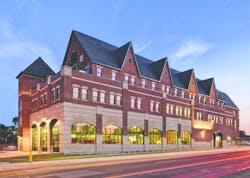You need a new fire station. Where do you begin? Every question seems to generate more questions and involves more people. Costs increase exponentially, and it’s starting to appear that the project will take twice as long as you planned. If you have never built a fire station, or haven’t built one in a long time, then the sooner you begin the research, the fewer mistakes and the less costly the errors are likely to be.
We contacted several fire chiefs from across the country with recently completed new fire stations and asked them to share some of the lessons they learned from building a fire station.
Where to begin
Denis McCarthy, fire chief and emergency management director for Norwalk, CT, was involved in the construction of a $15 million, 31,000-square-foot fire station that took 10 years to complete.
“Designing and building a new firehouse is a daunting task,” McCarthy says. “It regularly put me out of my comfort zone. Many times I was the final say on some controversial issues and building options. I felt that I had the responsibility to represent my vision of what was needed for the fire department and the community.”
By seeking as many opinions as possible, McCarthy believed he could best meet his responsibilities to complete a project that was financially feasible and create a building that would last 50 to 75 years.
McCarthy had seen other municipal projects that were not properly vetted by internal and political stakeholders, but believed he had the opportunity to follow best practices in engaging staff and the approving city boards and commissions in the process. “While this was time-consuming, it avoided any surprises and built support as the project moved through the process,” McCarthy says.
McCarthy also offered regular updates for department members, workshops and tours of both the building they demolished and the new building during construction. In addition, reviews and approvals from authorities were important parts of that process.
Planning committees
Forming the initial planning team is often the first step in the process of considering a new fire station. Bob Costello, fire chief of the Buckeye Fire Department, recently saw completion of the sixth fire station in the growing city of Buckeye, AZ. He believes that forming the initial team is too often more difficult than it should be. In the perfect world, asking for input from all of the stakeholders is the first step, but according to Costello, it can also make the process more difficult.
“I find keeping the initial planning team as small as you can will make the process smoother and most of the time you will reach the desired results,” Costello says. “It is a fine line between not enough information/input and too much.”
On the other hand, Bennington, NE, Fire and Rescue, is an all-volunteer department that provides fire and ALS ambulance service and, according to Assistant Fire Chief Ron Johnson, when it was time for a new fire station, they asked for volunteers who were willing to make the commitment “from design phase through final punch list with the general contractor.”
Johnson explains, “Our team consisted of the fire chief, two assistant chiefs and four firefighters with none having less than 10 years of [fire] experience.”
The design phase of the project took 11 months. Plans were updated and posted in the station to keep members abreast of the progress and for their input. The committee also visited numerous new fire stations in the area for ideas and to look at the quality of work from contractors.
Data-driven decisions
Jim Bloomer, assistant chief and current City of Mesa emergency manager for the Mesa Fire and Medical Department, also holds general contracting licenses in the state of Arizona for both residential and commercial construction. He is strong believer in maintaining records and knowing your numbers.
“Make data-driven decisions,” Bloomer says. “Nothing sells a fire station like good solid facts.” He continues: “How many calls are you getting in the area to be covered by the new station? Are you having many extended response times? How has the area changed in the last 10 years and where do you expect it to be in the next 10? Is there anything happening that will cause call volume to go up, such as new residential developments or commercial facilities? Keep in mind that in order to use data you have to have the data to use. Many departments don’t have the capability to retrieve call information.”
Hiring an architect
Each chief we spoke with emphasizes the importance of hiring an architect with experience in fire station design. Bloomer, however, cautions to be prepared for pressure from local officials.
“Many times architects tend to be very politically connected,” he says. “Because of this there is sometimes great pressure on departments and districts to use a local architect. But fire stations are highly technical buildings with unique challenges. The local architect may not have any background in fire station design.”
So how do you get around this challenge? Bloomer suggests, “You insist that if your community is going to go with the local architect that they hire an outside architectural firm with fire station experience as a consulting architect.”
The experienced architect will come in and meet with the home architect, decide on the scope of work that each will do, negotiate the price and move forward. In this scenario, the locals are happy and the department will benefit from the expertise of the consulting architect.
Department personnel and the process
From the initial effort, Norwalk’s Chief McCarthy worked at recruiting members to be involved in the process of investigating the feasibility of a new headquarter station.
“I recruited four members (shift commander/deputy chief, captain, lieutenant and firefighter) to attend the Kansas City Station Style Expo,” he explains. “They were enthusiastic participants in the project from then on.”
McCarthy also offered personnel who demonstrated a willingness and capacity the opportunity to work on key elements of the project and to be the lead for those areas. These included the following: History and Photographs, EOC, Kitchen, Exercise Space, Lounge and Training Area.
Serving the community
William A Pearson, Jr., captain and construction project manager for the Atlanta Fire-Rescue Department, explains that the city of Atlanta has Neighborhood Planning Unions (NPU) that are a part of each councilmember’s district. The fire department allows the community to offer their wishes and/or advice regarding the fire station that will be servicing their neighborhood. The community is kept abreast of the progress of the station through the councilmember’s office or through attending the monthly NPU meetings.
“Our stations belong to the community; it’s their tax dollars that are being spent and the stations are used quite frequently by the community,” Pearson says. “It’s a requirement that a community/training room is built within every station.”
Buckeye’s Chief Costello agrees, noting that, “The station needs to fit into and reflect the community. It should go without saying that the architecture should match and it should be a point of pride. There are no other civic buildings that are as imbedded in a community as a fire station and the community should think of it as theirs. We name our buildings firehouses as a reminder they are that much of the community they serve.”
Building a fire station is also adding to the history of a community. There is probably nothing more important than the exterior elevation and how it fits into the community. “This is the part everyone sees,” Costello adds. “I constantly hear comments on how the station looks and very few on the function.”
Taj Mahal or fire station?
In recent years, some fire departments have caught flak from members of the community for elaborate, expensive facilities. With fire calls declining and EMS calls increasing, understanding the changing role of the fire department in the community is an ongoing educational process. Fire stations are being built to last 50 to 75 years, so sustainability and environmental aspects must be considered. Health and safety are critical for the personnel dwelling in the building. Designing for quick response, community access and fitting into the neighborhood are all elements of design. Looking at the data, assessing the operational needs and predicting the future needs of the department are a tremendous undertaking. Every department is different from the next.
Captain Pearson shares something his supervisor told him before he retired: “We all want a Rolls Royce, but a lot of times we have to settle for the middle of the road and get a Honda or Toyota.” Pearson adds his own concluding thought: “We all want the best, but when it comes to a fire station, make sure you take care of the necessities first and then whatever you can get that would be more beneficial to you, get it.”
About the Author
Janet A. Wilmoth
Special Projects Director
Janet Wilmoth grew up in a family of firefighters in a suburb of Chicago. Wilmoth, who is owner of Wilmoth Associates, worked with Fire Chief magazine for 27 years until it closed in 2013. She currently is the project director for Firehouse, overseeing the Station Design Conference.

